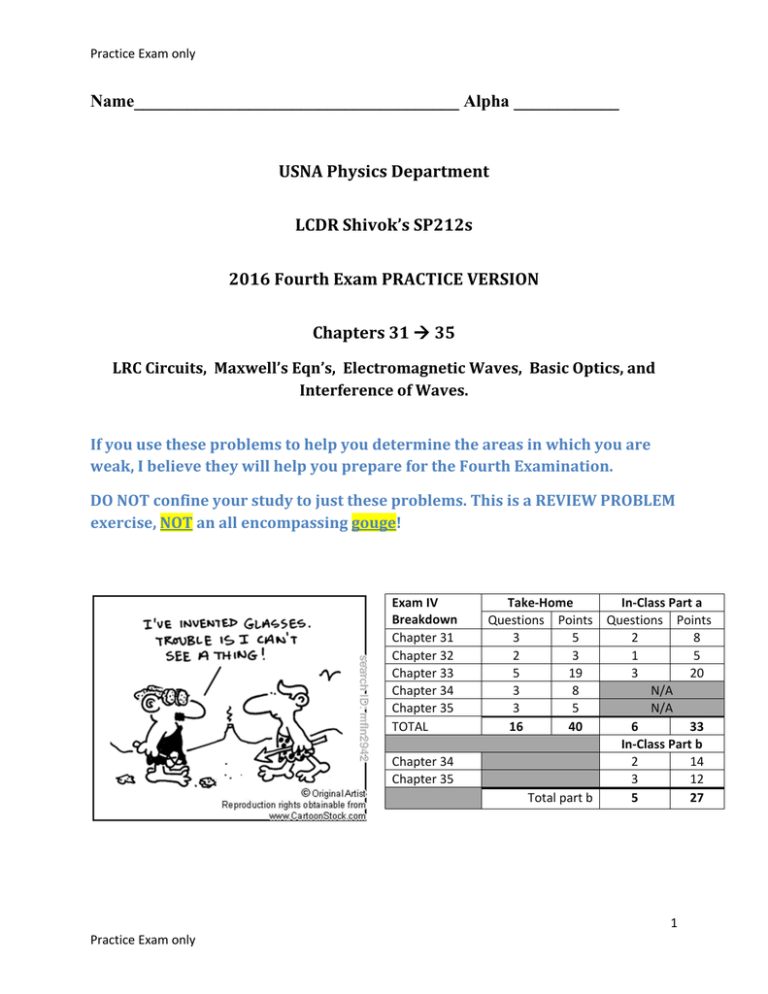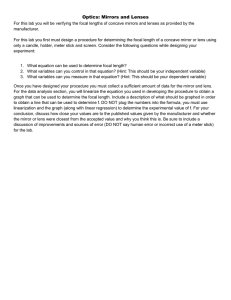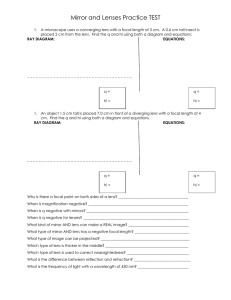Name_____________________________________ Alpha ____________ USNA Physics Department LCDR Shivok’s SP212s
advertisement

Practice Exam only Name_____________________________________ Alpha ____________ USNAPhysicsDepartment LCDRShivok’sSP212s 2016FourthExamPRACTICEVERSION Chapters3135 LRCCircuits,Maxwell’sEqn’s,ElectromagneticWaves,BasicOptics,and InterferenceofWaves. Ifyouusetheseproblemstohelpyoudeterminetheareasinwhichyouare weak,IbelievetheywillhelpyoupreparefortheFourthExamination. DONOTconfineyourstudytojusttheseproblems.ThisisaREVIEWPROBLEM exercise,NOTanallencompassinggouge! Exam IV Breakdown Chapter 31 Chapter 32 Chapter 33 Chapter 34 Chapter 35 TOTAL Chapter 34 Chapter 35 Take‐Home In‐Class Part a Questions Points Questions Points 3 5 2 8 2 3 1 5 5 19 3 20 3 8 N/A 3 5 N/A 16 40 6 33 In‐Class Part b 2 14 3 12 Total part b 5 27 1 Practice Exam only Practice Exam only Chapter 31 (16 points) 1. (2 points) The energy in an oscillating LC circuit containing a 1.25 H inductor is 5.70 μJ. The maximum charge on the capacitor is 175 μC. For a mechanical system with the same period, find the (a) mass, (b) spring constant, (c) maximum displacement, and (d) maximum speed. Show all work: 2. (2 points) The total energy in an LC circuit is 5.0 × 10–6 J. If C = 15 μF the charge on the capacitor is: A) 0.82 μC B) 8.5 μC C) 12 μC D) 17 μC E) 24 μC Show all work: 2 Practice Exam only Practice Exam only 3. (2 points) We desire to make an LC circuit that oscillates at 100 Hz using an inductance of 2.5 H. We also need a capacitance of: A) 1 F B) 1 mF C) 1 μF D) 100 μF E) 1 pF Show all work: 4. (2 points) An LC circuit has an inductance of 20 mH and a capacitance of 5.0 μF. At time t = 0 the charge on the capacitor is 3.0 μC and the current is 7.0 mA. The total energy is: A) 4.1 × 10–7 J B) 4.9 × 10–7 J C) 9.0 × 10–7 J D) 1.4 × 10–6 J E) 2.8 × 10–6 J Show all work: 3 Practice Exam only Practice Exam only 5. (4 points) A capacitor in an LC oscillator has a maximum potential difference of 15 V and a maximum energy of 360 μJ. At a certain instant the energy in the capacitor is 40 μJ. At that instant what is the emf induced in the inductor? A) zero B) 5 V C) 10 V D) 15 V E) 20 V Show all work: 6. (4 points) An RLC circuit has a resistance of 200 Ω and an inductance of 15 mH. Its oscillation frequency is 7000 Hz. At time t = 0 the charge is 284 nC on the capacitor. After five complete cycles the charge on the capacitor is: A) 0 B) 1.8 × 10–8 A C) 2.1 × 10–10 A D) 2.3 × 10–12 A E) 2.4 × 10–9 A Show all work: 4 Practice Exam only Practice Exam only Chapter 32 (16 points) 7. (2 points) Which of Maxwell’s equations can be used, along with a symmetry argument, to calculate the electric field of a point charge? Explain why and how: 8. (4 points) Write the integral form of the equation for Maxwell‐Ampere’s Law and explain every term in the equation? Equation and Explain: 5 Practice Exam only Practice Exam only 9. (2 points) Which of the following equations, along with a symmetry argument, can be used to calculate the magnetic field between the plates of a charging parallel plate capacitor with circular plates Explain: 10. (2 points) Displacement current is: Explain: 6 Practice Exam only Practice Exam only 11. (4points) A 1‐A current is used to charge a parallel plate capacitor. A large square piece of paper is placed between the plates and parallel to them so it sticks out on all sides. The value of the integral ∮ ∙ around the perimeter of the paper is: A) 2 T ⋅m B) 4π × 10–7 T ⋅m C) 8.85 × 10–12 T ⋅m D) 10–7 T ⋅m E) not determined from the given quantities Show all work: 12. (2points) Two of Maxwellʹs equations contain an integral over a closed surface. For them the infinitesimal vector area is always: A) tangent to the surface B) perpendicular to the surface and pointing outward C) perpendicular to the surface and pointing inward D) tangent to a field line E) perpendicular to a field line Explain: 7 Practice Exam only Practice Exam only Chapter 33 (34 points) 13. (4 points) The diagram shows the passage of a ray of light from air into a substance X. The index of refraction of X is: A) 0.53 B) 0.88 C) 1.9 D) 2.2 E) 3.0 Show all work: 14. (6 points) The critical angle for total internal reflection at a diamond‐air interface is 25°. Suppose light is incident at an angle of θ with the normal. Total internal reflection will occur if the incident medium is A) air and θ = 25° B) air and θ > 25° C) air and θ < 25° D) diamond and θ < 25° E) diamond and θ > 25° Why did you choose that answer? [Include a drawing with your explanation] 8 Practice Exam only Practice Exam only 15. (6 points) A beam of light traveling in air strikes the surface of a unknown solution of at an angle of 34± to the vertical. If the beam is refracted at an angle of 29± to the vertical, then the speed of the light in the unknown solution is closest to A) 1.5 x 108 m/s B) 1.7 x 108 m/s C) 2.0 x 108 m/s D) 2.3 x 108 m/s E) 2.6 x 108 m/s Show all work: 16. (8 points) In figure below, light is incident at angle θ1 = 41˚ on a boundary between two transparent materials. Some of the light travels down through the next three layers of transparent materials, while some of it reflects upward and then escapes into the air. If n1 = 1.3, n2 = 1.4, n3 = 1.3 and n4 = 1.5, what is the value of θ4 and θ5 Show all work: 9 Practice Exam only Practice Exam only 17. (7 points) An unpolarized beam of light has intensity I0. It is incident on two ideal polarizing sheets. The angle between the axes of polarization of these sheets is θ. Find θ if the emerging light has intensity I0/4: A) sin B) sin C) cos D) cos E) tan 1/√5) 1/√2 Show all work: 18. (3 points) The relation θincident = θreflected, which applies as a ray of light strikes an interface between two media, is known as: A) Faradayʹs law B) Snellʹs law C) Ampereʹs law D) Coleʹs law E) none of these Explain: 10 Practice Exam only Practice Exam only Chapter 34 (34 points) 19. (4 points) A concave shaving mirror has a radius of curvature of +28.5 cm. It is positioned so that the (upright) image of a manʹs face is 1.76 times the size of the face. How far is the mirror from the face? A. 6.15 x 101 cm B. 61.7 x 102 cm C. 0.61 x 10‐3 m D. 2.3 x 10‐3 inches E. 2.6 x 10‐3 m Show all work: 20. (2 points) A virtual image is one… A. toward which light rays converge but do not pass through B. from which light rays diverge but do not pass through C. from which light rays diverge as they pass through D. toward which light rays converge and pass through E. with a ray normal to a mirror passing through it Why did you choose that answer? 11 Practice Exam only Practice Exam only 21. (8 points) Two converging lenses are placed 100 cm apart. The focal length of the first lens is 30 cm and the focal length of the second lens is 10 cm. An object is placed 50 cm to the left of the first lens as shown. Tell me everything you know or can find out about the final image: Lens 1 F1 F1 Lens 2 F2 F2 Show all work (including magnification calculation and the ray traces to determine image 2 location): 22. (2 points) Where must an object be placed in front of a converging lens in order to obtain a virtual image? A) At the focal point B) At twice the focal length C) Greater than the focal length D) Between the focal point and the lens E) Between the focal length and twice the focal length Explain: 12 Practice Exam only Practice Exam only 23. (6 points) Consider the object‐diverging lens system shown. An object is placed 30cm to the left of the diverging lens with a focal length of ‐20cm. Draw at least two ray traces and FULLY describe the final image. Show all work: 24. (4 points) A double concave lens is made using a material with a refractive index of 1.20. The magnitude of the radius of the curvature of the front face is 20.0 cm and the magnitude of the radius of curvature of the back face is 30.0 cm. The focal length of the lens is closest to: Show all work: 13 Practice Exam only Practice Exam only 25. (8 points) Consider the object‐concave mirror system shown. (a) Label the focal point with an F, the radius of curvature with C, and the object with O. (b) Draw the ray diagram (at least 3 rays) for light originating at the tip of the object. (c) Draw the image. (d) If the distance from the object to the mirror is 7 m and the radius of curvature is 4 m, find the distance from the image to the mirror. Is the image real or virtual, upright or inverted? Show all work: 14 Practice Exam only Practice Exam only Chapter 35 (14 points) 26. (3 points) A thin film of acetone (n = 1.36) coats a thick glass plate (n = 1.52). White light is incident normal to the film. In the reflections, fully destructive interference occurs at 635.75 nm and fully constructive interference at 445 nm. Calculate the thickness of the acetone film. Air acetone (n=1.36) glass (n=1.52) Show all work 27. (2 points) A Young’s two‐slit experiment is performed with monochromatic light of wavelength 632.8 nm. In the interference pattern on a screen 3.0m away from the slits, the second minimum is 5 mm away from the center of the pattern. What is the separation between the slits? Show all work: 15 Practice Exam only Practice Exam only 26. (9 points) Use the following diagram to answer the following parts of this question: Air Soap (n=1.40) Water (n=1.33) a. (4 points) A thin Soap layer on water produces enhanced reflection through constructive interference at wavelength 600nm when light is normally incident from air. The refractive indices of the Soap and water are 1.40 and 1.33, respectively. The second smallest thickness of the Soap layer is closest to: Show all work: b. (5 points) Assume instead that the Soap film was of thickness 600‐nm‐thick and has an index of refraction of n = 1.40. It is illuminated with white light in a direction perpendicular to the film. For how many different wavelengths in the visible light spectrum are there fully constructive interference and what are those wavelengths? Show all work: 16 Practice Exam only Practice Exam only Make sure you showed all your work for all problems! Do the idiot check on your math… Does 50 – 30 = 20 or did you fat finger the calculator? 17 Practice Exam only







